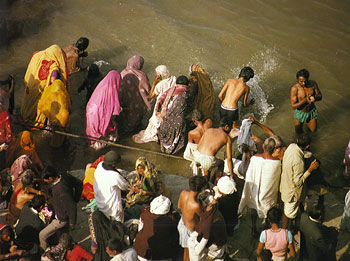
During the twentieth century, the attendance at kumbha mela has grown significantly. No other gathering in the history of mankind—including the World's Fair and the Olympics—can rival the participation witnessed at the kumbha mela. In a league of its own, the kumbha mela has been competing with itself, setting attendance records decade after decade. By 1977, the number of pilgrims at kumbha mela soared to fifteen million. In 1989, thirty million pilgrims attended the kumbha mela, the largest gathering of any type in modern history.
The 1989 kumbha mela also saw record expenditures, as the Indian government spent more than eight million dollars on preliminary organization. According to national newspaper reports, the Kumbha Mela occupied 3,600 acres; arrangements were made to provide 5,000 gallons of purified drinking water per minute to the festival grounds; 6,500 buses provided short and long-range transportation; 16,000 outlets and 6,000 poles provided electrical facilities; 6,000 sweepers and sanitation employees worked around the clock to maintain health standards; 13,500 latrines and lavatories were opened to the public; 9 pontoon bridges spanned the Ganges at intervals; 22 fire-fighting stations were erected; 20,000 policemen and the Indian National Guard kept a constant vigil at checkpoints and with closedcircuit TV to guard against traffic congestion and other possible disturbances; 300 lifeguards and the Indian Boy Scouts constantly patrolled the bank of the river to assure safety to bathers; 400 boats stood at the docks to carry pilgrims across the rivers; and 100 doctors and nurses were on call around the clock at medical assistance stations-a mammoth administrative task.
